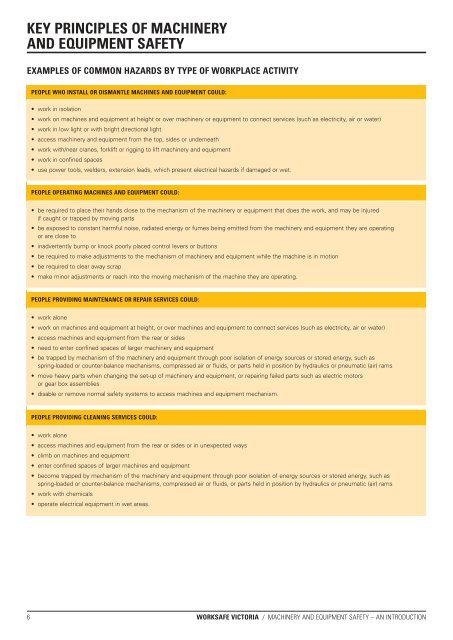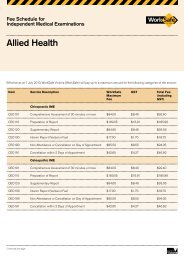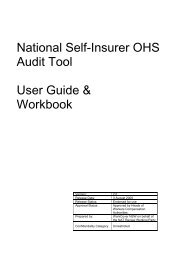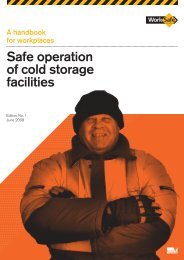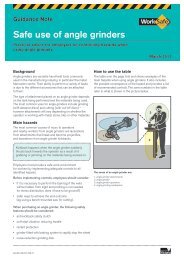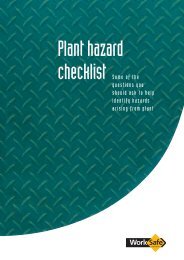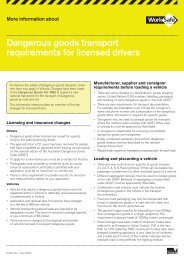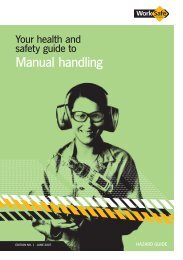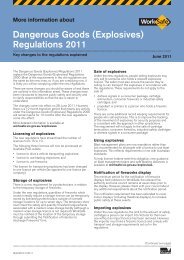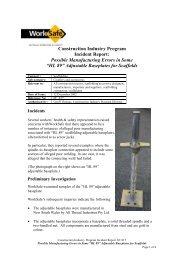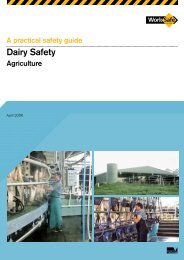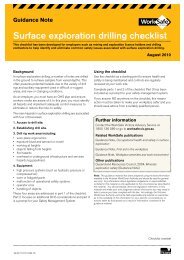Machinery and Equipment Safety - An Introduction - WorkSafe Victoria
Machinery and Equipment Safety - An Introduction - WorkSafe Victoria
Machinery and Equipment Safety - An Introduction - WorkSafe Victoria
You also want an ePaper? Increase the reach of your titles
YUMPU automatically turns print PDFs into web optimized ePapers that Google loves.
KEY PRINCIPLES OF MACHINERY<br />
AND EQUIPMENT SAFETY<br />
EXAMPLES OF COMMON HAZARDS BY TYPE OF WORKPLACE ACTIVITY<br />
PEOPLE WHO INSTALL OR DISMANTLE MACHINES AND EQUIPMENT COULD:<br />
• work in isolation<br />
• work on machines <strong>and</strong> equipment at height or over machinery or equipment to connect services (such as electricity, air or water)<br />
• work in low light or with bright directional light<br />
• access machinery <strong>and</strong> equipment from the top, sides or underneath<br />
• work with/near cranes, forklift or rigging to lift machinery <strong>and</strong> equipment<br />
• work in confined spaces<br />
• use power tools, welders, extension leads, which present electrical hazards if damaged or wet.<br />
PEOPLE OPERATING MACHINES AND EQUIPMENT COULD:<br />
• be required to place their h<strong>and</strong>s close to the mechanism of the machinery or equipment that does the work, <strong>and</strong> may be injured<br />
if caught or trapped by moving parts<br />
• be exposed to constant harmful noise, radiated energy or fumes being emitted from the machinery <strong>and</strong> equipment they are operating<br />
or are close to<br />
• inadvertently bump or knock poorly placed control levers or buttons<br />
• be required to make adjustments to the mechanism of machinery <strong>and</strong> equipment while the machine is in motion<br />
• be required to clear away scrap<br />
• make minor adjustments or reach into the moving mechanism of the machine they are operating.<br />
PEOPLE PROVIDING MAINTENANCE OR REPAIR SERVICES COULD:<br />
• work alone<br />
• work on machines <strong>and</strong> equipment at height, or over machines <strong>and</strong> equipment to connect services (such as electricity, air or water)<br />
• access machines <strong>and</strong> equipment from the rear or sides<br />
• need to enter confined spaces of larger machinery <strong>and</strong> equipment<br />
• be trapped by mechanism of the machinery <strong>and</strong> equipment through poor isolation of energy sources or stored energy, such as<br />
spring-loaded or counter-balance mechanisms, compressed air or fluids, or parts held in position by hydraulics or pneumatic (air) rams<br />
• move heavy parts when changing the set-up of machinery <strong>and</strong> equipment, or repairing failed parts such as electric motors<br />
or gear box assemblies<br />
• disable or remove normal safety systems to access machines <strong>and</strong> equipment mechanism.<br />
PEOPLE PROVIDING CLEANING SERVICES COULD:<br />
• work alone<br />
• access machines <strong>and</strong> equipment from the rear or sides or in unexpected ways<br />
• climb on machines <strong>and</strong> equipment<br />
• enter confined spaces of larger machines <strong>and</strong> equipment<br />
• become trapped by mechanism of the machinery <strong>and</strong> equipment through poor isolation of energy sources or stored energy, such as<br />
spring-loaded or counter-balance mechanisms, compressed air or fluids, or parts held in position by hydraulics or pneumatic (air) rams<br />
• work with chemicals<br />
• operate electrical equipment in wet areas.<br />
6 WORKSAFE VICTORIA / MACHINERY AND EQUIPMENT SAFETY – AN INTRODUCTION


